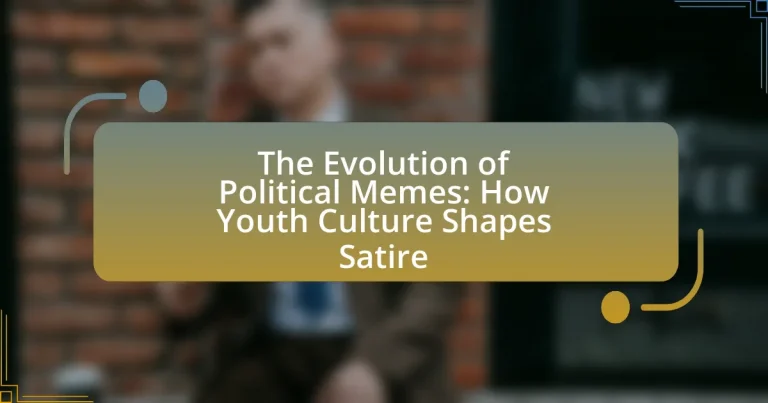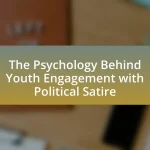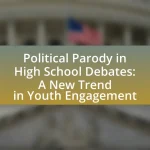Political memes are humorous digital content that comment on political events and ideologies, playing a significant role in engaging youth culture and facilitating political discourse. This article explores the evolution of political memes, tracing their development from simple images to complex multimedia formats, particularly during pivotal events like the 2008 and 2016 U.S. presidential elections. It examines how technological advancements and social media have influenced the creation and dissemination of these memes, their impact on public opinion, and the ethical considerations surrounding misinformation. Additionally, the article highlights the ways in which political memes reflect the values of younger generations and their potential to mobilize youth engagement in political issues.
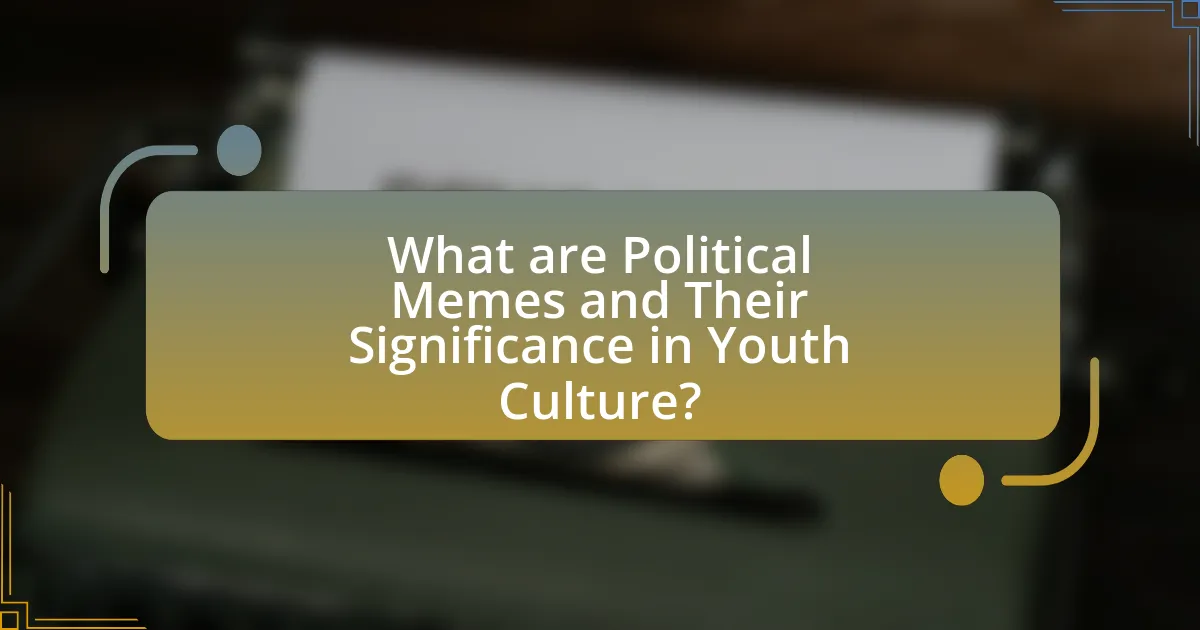
What are Political Memes and Their Significance in Youth Culture?
Political memes are humorous images, videos, or text that comment on political events, figures, or ideologies, often shared widely on social media platforms. Their significance in youth culture lies in their ability to engage young people in political discourse, making complex issues more accessible and relatable. Research indicates that 55% of young adults use memes to express political opinions, highlighting their role as a tool for political engagement and activism. Additionally, political memes often reflect and shape the values and beliefs of youth, fostering a sense of community and shared identity among users.
How have political memes evolved over time?
Political memes have evolved significantly from simple text-based images to complex multimedia formats that reflect current events and cultural sentiments. Initially, political memes emerged in the early 2000s as basic images with captions, often shared on forums and social media platforms. As technology advanced, the introduction of platforms like Twitter and Instagram allowed for rapid dissemination and remixing of content, leading to more sophisticated and interactive forms of political satire.
The 2008 U.S. presidential election marked a pivotal moment, with memes like “Yes We Can” becoming viral symbols of political movements. By the 2016 election, memes became integral to political campaigns, with candidates and their supporters using them to influence public opinion and engage younger voters. Research indicates that memes can shape political discourse, as they often encapsulate complex ideas in easily digestible formats, making them particularly effective among youth audiences.
The rise of video memes and GIFs further transformed the landscape, allowing for dynamic storytelling and emotional engagement. This evolution reflects broader trends in digital communication, where immediacy and relatability are key to capturing attention. Overall, political memes have transitioned from niche internet culture to a mainstream tool for political expression and engagement, illustrating the intersection of technology, culture, and politics.
What historical events influenced the rise of political memes?
The rise of political memes has been significantly influenced by the advent of the internet and social media platforms, particularly during the 2008 U.S. presidential election. This election marked a pivotal moment where online communication became a primary medium for political discourse, allowing memes to spread rapidly and reach a wide audience. The use of platforms like Facebook and Twitter enabled users to create and share humorous content that critiqued candidates and political issues, exemplified by the viral spread of images and videos that encapsulated political sentiments in a digestible format. Additionally, events such as the Arab Spring in 2010 showcased how memes could mobilize youth and influence political movements, further solidifying their role in modern political communication.
How do technological advancements impact the creation of political memes?
Technological advancements significantly enhance the creation of political memes by providing accessible tools and platforms for rapid content generation and dissemination. The proliferation of social media platforms, such as Twitter and Instagram, allows users to create and share memes instantly, reaching a global audience. Additionally, advancements in graphic design software and mobile applications enable users to produce high-quality visuals with minimal technical skills. For instance, the rise of meme generators has democratized meme creation, allowing individuals to participate in political discourse regardless of their background. This accessibility has led to an increase in the volume and diversity of political memes, reflecting a wide range of perspectives and cultural contexts.
Why are political memes particularly popular among youth?
Political memes are particularly popular among youth because they provide a relatable and accessible way to engage with complex political issues. Young people, who are often more active on social media platforms, use memes to express their opinions, share information, and participate in political discourse in a format that is visually appealing and easily digestible. Research indicates that 55% of young adults in the U.S. report using social media as a primary source for news, highlighting the role of memes in shaping their political understanding and engagement.
What role does social media play in the dissemination of political memes?
Social media serves as a primary platform for the dissemination of political memes, enabling rapid sharing and widespread visibility. The interactive nature of social media allows users to create, modify, and circulate memes, which can quickly reach large audiences, particularly among younger demographics. According to a study by the Pew Research Center, 55% of U.S. adults aged 18-29 reported getting news from social media, highlighting its role in shaping political discourse. This environment fosters engagement and discussion, making political memes a potent tool for satire and commentary on current events.
How do political memes reflect the values and beliefs of younger generations?
Political memes reflect the values and beliefs of younger generations by serving as a medium for social commentary and political engagement. These memes often encapsulate issues such as climate change, social justice, and equality, which resonate strongly with youth. For instance, a study by the Pew Research Center found that 70% of younger adults prioritize climate action, and memes addressing this topic often go viral, indicating their alignment with youth priorities. Additionally, political memes utilize humor and relatability, making complex political issues more accessible and engaging for younger audiences, thereby fostering a sense of community and shared values among them.

How Do Political Memes Shape Satire in Contemporary Discourse?
Political memes shape satire in contemporary discourse by providing a rapid and accessible means of critiquing political figures and events. These memes often utilize humor, irony, and exaggeration to convey complex political messages, making them easily digestible for a wide audience. For instance, a study by the Pew Research Center found that 55% of U.S. adults encounter political memes on social media, indicating their prevalence and influence in shaping public opinion. This widespread engagement allows memes to serve as a form of grassroots commentary, reflecting and amplifying the sentiments of youth culture, which increasingly relies on digital platforms for expression.
What techniques are commonly used in political memes to convey satire?
Political memes commonly use techniques such as exaggeration, juxtaposition, and irony to convey satire. Exaggeration amplifies characteristics or behaviors of political figures, making them appear more ridiculous or absurd, which highlights flaws in their actions or policies. Juxtaposition places contrasting images or ideas side by side, creating a stark comparison that underscores the absurdity of political situations. Irony involves presenting a situation that is contrary to what is expected, often revealing hypocrisy or contradictions in political discourse. These techniques effectively engage audiences by provoking thought and humor, making complex political issues more accessible and relatable.
How does humor enhance the effectiveness of political memes?
Humor enhances the effectiveness of political memes by making complex political messages more relatable and engaging for audiences. When humor is incorporated, it simplifies the communication of political ideas, allowing individuals to grasp and share these concepts more easily. Research indicates that humorous content is more likely to be shared on social media platforms, increasing its reach and impact. For instance, a study published in the journal “Computers in Human Behavior” found that humorous memes significantly boost user engagement and sharing behavior, demonstrating that humor not only captures attention but also fosters a sense of community among users who resonate with the satire.
What are the risks of misinterpretation in political satire through memes?
The risks of misinterpretation in political satire through memes include the potential for spreading misinformation and reinforcing biases. Memes often simplify complex political issues, leading audiences to misunderstand the nuances involved. For instance, a meme that exaggerates a politician’s stance may cause viewers to form inaccurate perceptions about their policies. Research indicates that 59% of social media users encounter misinformation, which can be exacerbated by the viral nature of memes. Additionally, memes can create echo chambers, where individuals only engage with content that aligns with their pre-existing beliefs, further distorting their understanding of political realities.
In what ways do political memes influence public opinion?
Political memes influence public opinion by shaping perceptions, reinforcing beliefs, and facilitating political discourse. They often simplify complex political issues into relatable and shareable content, making it easier for individuals to engage with and understand political topics. Research indicates that memes can sway opinions by appealing to emotions and humor, which can lead to increased sharing and discussion among peers. For instance, a study by the Pew Research Center found that 55% of social media users have encountered political memes, and among those, 40% reported that these memes influenced their views on political issues. This demonstrates the significant role that political memes play in shaping public opinion, particularly among younger demographics who are more active on social media platforms.
How can political memes mobilize youth engagement in political issues?
Political memes can mobilize youth engagement in political issues by simplifying complex topics into relatable and shareable content that resonates with younger audiences. This form of communication leverages humor and visual elements to capture attention, making political discourse more accessible. Research indicates that memes can increase political awareness and participation; for instance, a study by the Pew Research Center found that 55% of young adults engage with political content on social media, often through memes. By fostering a sense of community and shared identity, political memes encourage discussions and activism among youth, ultimately driving them to participate in political processes.
What evidence exists to support the impact of political memes on voter behavior?
Political memes significantly influence voter behavior, as evidenced by studies showing their role in shaping political opinions and engagement. Research conducted by the Pew Research Center in 2019 found that 55% of social media users reported that memes and humorous content affected their political views. Additionally, a study published in the journal “Political Communication” by researchers at the University of California, Irvine, demonstrated that exposure to political memes increased political knowledge and motivated younger voters to participate in elections. These findings indicate that political memes not only disseminate information but also actively engage and mobilize voters, particularly among youth demographics.
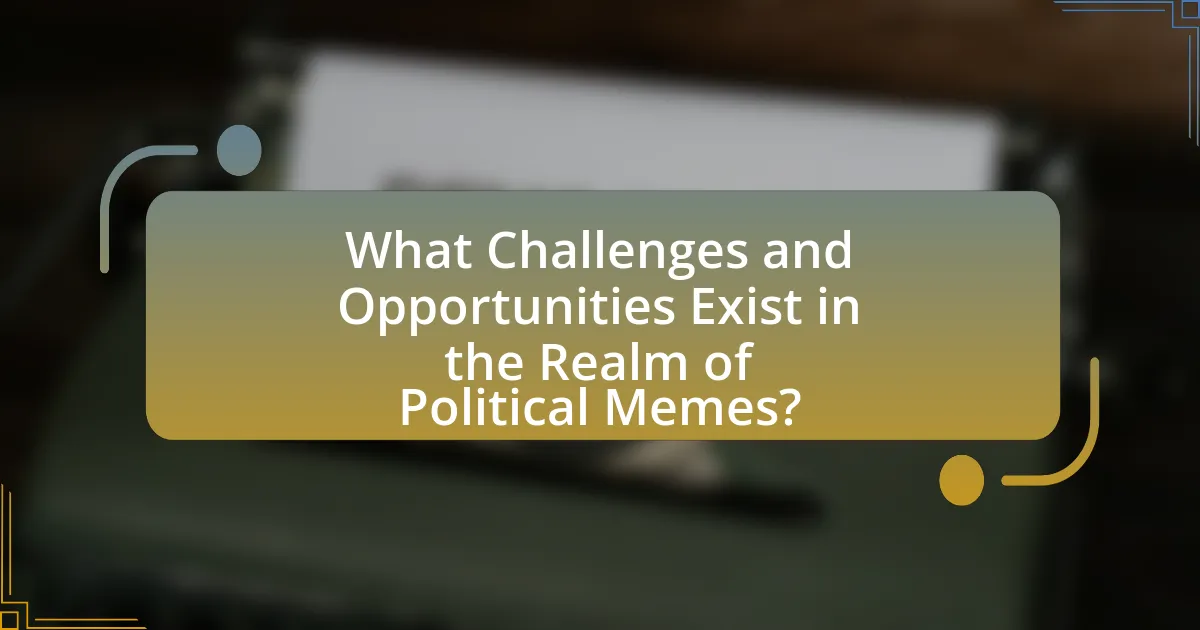
What Challenges and Opportunities Exist in the Realm of Political Memes?
Political memes face challenges such as misinformation and polarization, while also presenting opportunities for engagement and political discourse. Misinformation can spread rapidly through memes, leading to distorted perceptions of political issues, as evidenced by studies showing that false information is more likely to be shared on social media platforms. Additionally, political memes can contribute to polarization by reinforcing existing beliefs and creating echo chambers, which can hinder constructive dialogue. Conversely, political memes offer opportunities for youth engagement, as they can simplify complex political topics and make them more accessible, fostering discussions among younger audiences. Research indicates that memes can serve as a tool for activism, mobilizing support for social movements and encouraging political participation, particularly among younger demographics who are more adept at using digital platforms for communication.
What ethical considerations arise from the use of political memes?
The ethical considerations arising from the use of political memes include misinformation, manipulation of public opinion, and the potential for harm to individuals or groups. Misinformation occurs when memes distort facts or present false narratives, which can mislead audiences and influence their beliefs. For example, a study by the Pew Research Center found that 64% of Americans believe fabricated news stories cause confusion about basic facts. Manipulation of public opinion is evident when memes are designed to evoke emotional responses, often bypassing rational analysis, which can lead to polarized views. Additionally, political memes can perpetuate stereotypes or incite hatred, posing risks to marginalized communities. The viral nature of memes amplifies these ethical concerns, as they can spread rapidly without context or accountability.
How can misinformation spread through political memes?
Misinformation can spread through political memes by leveraging emotional appeal and rapid sharing on social media platforms. Political memes often simplify complex issues into easily digestible images or phrases, which can distort facts or present biased viewpoints. For instance, a study by the MIT Media Lab found that false news stories spread significantly faster on Twitter than true stories, primarily due to their sensational nature, which is often reflected in memes. This rapid dissemination is facilitated by the viral nature of social media, where users share content without verifying its accuracy, leading to widespread acceptance of misleading information.
What responsibilities do creators of political memes have?
Creators of political memes have the responsibility to ensure accuracy and avoid spreading misinformation. This is crucial because political memes can significantly influence public opinion and voter behavior, as evidenced by studies showing that memes can shape perceptions of political figures and issues. Additionally, creators should consider the potential impact of their content on societal discourse, as memes can either promote constructive dialogue or exacerbate polarization. By adhering to ethical standards and fact-checking their work, creators can contribute positively to political discussions and help maintain a more informed electorate.
How can youth effectively use political memes for advocacy?
Youth can effectively use political memes for advocacy by creating relatable and shareable content that resonates with their peers and highlights social issues. Memes can simplify complex political messages, making them accessible and engaging, which is crucial for capturing the attention of a younger audience. For instance, studies show that visual content is 40 times more likely to be shared on social media than text-based content, emphasizing the power of memes in spreading awareness. Additionally, youth can leverage platforms like Instagram and TikTok, where memes thrive, to amplify their messages and encourage discussions around political topics. By using humor and satire, they can challenge the status quo and mobilize their peers to take action, as evidenced by the viral success of memes during movements like Black Lives Matter and climate activism.
What strategies can enhance the positive impact of political memes in activism?
To enhance the positive impact of political memes in activism, creators should focus on clarity, relatability, and shareability. Clear messaging ensures that the intended political message is easily understood, which is crucial for engagement. Relatable content resonates with the audience’s experiences and emotions, fostering a sense of connection and urgency. Shareability is vital as memes that are easily shared across social media platforms can reach a broader audience, amplifying their impact. Research indicates that memes with strong emotional appeal are more likely to be shared, thus increasing their potential to influence public opinion and mobilize action.
How can young creators navigate the balance between humor and seriousness in political memes?
Young creators can navigate the balance between humor and seriousness in political memes by understanding their audience and the context of the political issue being addressed. By analyzing the reactions to previous political memes, creators can gauge what types of humor resonate while still conveying a serious message. For instance, memes that use satire effectively can highlight absurdities in political situations without trivializing the underlying issues, as seen in the widespread use of memes during significant political events like elections or protests. This approach allows creators to engage their audience emotionally and intellectually, ensuring that the humor enhances rather than undermines the seriousness of the political discourse.
